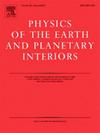Spatial variation of crustal anisotropy in Simeulue Island, Indonesia, from shear wave splitting analysis
IF 1.9
3区 地球科学
Q2 GEOCHEMISTRY & GEOPHYSICS
引用次数: 0
Abstract
Simeulue Island sits near the northern subduction margin of the Sumatran Megathrust, which is characterized by high tectonic activities and earthquakes. The oblique subduction along this margin has developed a complicated crustal deformation on the island, including faulting, uplifting and crustal segmentation. In the subduction zone, crustal anisotropy is often caused by stress-induced anisotropy in which the anisotropy direction is parallel to the stress direction. However, the complex crustal structure around the study area may produce a complicated anisotropy pattern. Here, we measure crustal seismic anisotropy from shear wave splitting analysis using the seismic data recorded at eight temporary stations spread across Simeulue Island. We apply the 2-D tomographic inversion and spatial averaging technique to map the splitting anisotropy patterns around the region. This research allows us to gain new insight into the crustal deformation pattern and its relationship with the complicated crustal structure beneath the island. The splitting result shows variations of anisotropy pattern around the study area. The spatially averaged fast directions at the northern region are trench-parallel, consistent with the strike of the geological features resulting from the strain partitioning deformation of the oblique convergence. Higher strength anisotropy is also observed in this area, indicating that the local fault system may strongly contribute to the crustal anisotropy. In the southern part of the island, the spatial averaging of fast direction gives a consistent pattern with the maximum regional stress direction, suggesting that anisotropy is mainly associated with stress-aligned microcracks. The central part of the island exhibits different splitting directions, marking the boundary of the geological structures between the areas in the north and south of the island. This pattern is also accompanied by high-strength anisotropy, suggesting that the source may be associated with the subducting geological structures beneath the area playing a significant role in the rupture barrier of the great events, as suggested by several previous studies.

印尼Simeulue岛地壳各向异性的空间变化——基于横波分裂分析
Simeulue岛位于苏门答腊大逆冲构造北俯冲边缘附近,构造活动频繁,地震频繁。沿这一边缘的斜向俯冲作用在岛内形成了复杂的地壳变形,包括断裂、隆升和地壳分割。在俯冲带,地壳各向异性往往是由应力诱导的各向异性引起的,各向异性方向与应力方向平行。然而,研究区周围复杂的地壳结构可能产生复杂的各向异性格局。本文利用分布在Simeulue岛的8个临时台站记录的地震数据,通过横波分裂分析测量地壳地震各向异性。我们应用二维层析反演和空间平均技术绘制了该区域周围的分裂各向异性图。这项研究使我们对地壳变形模式及其与岛下复杂地壳结构的关系有了新的认识。劈裂结果表明,各向异性模式在研究区周围发生了变化。北部地区的空间平均快速方向与海沟平行,与斜辐合带应变分区变形导致的地质特征走向一致。该地区的各向异性强度较高,表明局部断裂系统可能是造成地壳各向异性的主要原因。在岛南部,快速方向的空间平均与最大区域应力方向一致,表明各向异性主要与应力向微裂纹有关。岛中部呈现不同的分裂方向,标志着岛南北地区地质构造的分界线。这种模式还伴随着高强度的各向异性,这表明震源可能与该地区下方的俯冲地质构造有关,这些地质构造在大事件的破裂屏障中起着重要作用,正如先前的几项研究所表明的那样。
本文章由计算机程序翻译,如有差异,请以英文原文为准。
求助全文
约1分钟内获得全文
求助全文
来源期刊

Physics of the Earth and Planetary Interiors
地学天文-地球化学与地球物理
CiteScore
5.00
自引率
4.30%
发文量
78
审稿时长
18.5 weeks
期刊介绍:
Launched in 1968 to fill the need for an international journal in the field of planetary physics, geodesy and geophysics, Physics of the Earth and Planetary Interiors has now grown to become important reading matter for all geophysicists. It is the only journal to be entirely devoted to the physical and chemical processes of planetary interiors.
Original research papers, review articles, short communications and book reviews are all published on a regular basis; and from time to time special issues of the journal are devoted to the publication of the proceedings of symposia and congresses which the editors feel will be of particular interest to the reader.
 求助内容:
求助内容: 应助结果提醒方式:
应助结果提醒方式:


